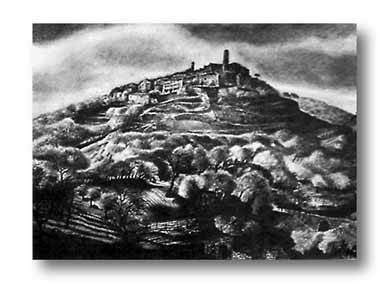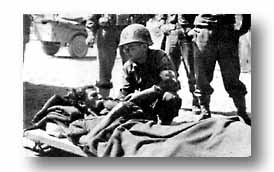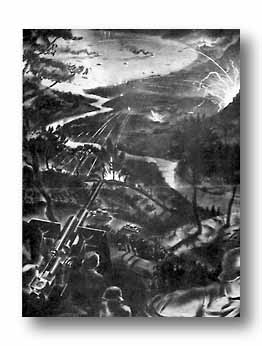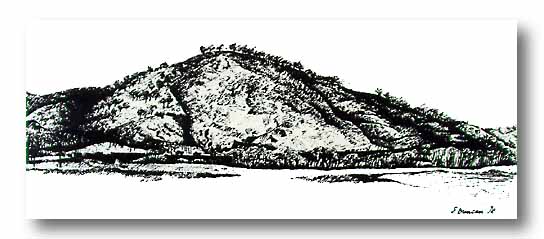ALTAVILLA Throughout the next few days the struggle raged furiously back and forth over the Altavilla hills. On the morning of September 11, the 142nd Infantry's attack against Hill 424 and the high ground beyond succeeded with deceptive ease. The 1st Battalion began the march on Altavilla itself and occupied it shortly after noon.
During that night enemy units infiltrated around Hill 424. At daybreak T-Patch troops received fire from so many directions that the enemy seemed to be everywhere. Communications were severed; no amount of work could keep the lines open. The fight grew steadily more desperate; the enemy broke through and pushed down to Altavilla, cutting the battalion in two parts, then regained Hill 424. Now to retake and hold Altavilla, a greater force would be needed. In the meantime, units of the 141st Infantry were moved north of the Sele River to strengthen the left of the Sixth Corps, and the 2nd Battalion, 143rd Infantry was ordered into an exposed position between the Sele and Calore Rivers to fill a gap in the center of the Corps. Colonel Martin was ordered to assemble a force from two regiments for an assault on Altavilla and Hill 424. The 3rd Battalion, 142nd Infantry marched from Albanella; the 3rd Battalion, 143rd Infantry moved on to an assembly area northwest of Altavilla. Artillery preparation for the attack on Altavilla began at 0545 on the 13th. The infantry jumped off 15 minutes later, and the artillery advanced its core concentrations to support the attack.
The 1st Battalion, 142nd Infantry came up through the draw south of Altavilla, where the length of its formation was caught in heavy concentrations of German artillery fire. The companies became disorganized and it was nearly mldnlght before the 1st Battalion could be pulled together On the left the 3rd Battalion. 143rd Infantry, under Lt. Col. Barnett, pushed up the ridge northwest of Altavilla. The battalion reached the top of the ridge and sent Company K into Altavilla to protect the right flank. That same day the Germans launched a powerful tank attack on the Corps center against the exposed 2nd Battalion, 143rd Infantry, attacking it from three sides. The battalion was overwhelmed and completely disorganized, and many of the men were surrounded and captured by the Germans. This misfortune gave the enemy full possession of the ground between the Sele and Calore Rivers and paved the way for a counterattack, which was not long delayed, on the exposed left and rear of the 36th Division, now in possession of Altavilla. The enemy's counterattack was made simultaneously from the front at Altavilla and from the left rear across the Calore River. Time and again the Germans, attacking from the front, beat against the battalion defenses and every time they were thrown back. But German troops advancing across the Calore River from the North and rear were not strongly opposed. They gained a position in rear of the infantry battalions from which they fired on our artillery battalions and forced them to change positions. Snipers and machine gunners opened up on our infantry from the rear, the Germans threatening to cut off our troops in Altavilla.
When, after dark, the order came to withdraw, Company K had been surrounded and had to remain in Altavilla until the night of the 14th. The rest of the battalion and the two battalions of the 142nd Infantry withdrew to La Cosa Creek. The effort to recapture and hold Hill 424, so nearly accomplished, had failed. All night long, a new and last line of defense was hastily formed along the little La Cosa Creek from the Calore to Mt. Soprano. It was but a slight natural barrier but the best defensive position available. To man the defense it was necessary to draw troops from every possible source, for the 36th had been so extended and had suffered so heavily during the 13th that it did not have the strength to adequately occupy and prepare the position. That same night in the Gulf of Salerno, naval vessels moved shoreward to pound enemy installations with their heavy shells, and Allied planes carried out one of the war's heaviest bombings in support of tactical operations. Before midnight, massed flights of C--47's, friendly orange identification lights glowing, swept in from the sea bearing paratroop reinforcements from Sicily. Confidence mounted and determination settled.
For five more days German and Allied troops sparred. Then on the 19th, after paratroopers of the 82nd Airborne had recaptured Altavilia and elements of the 36th Division had pushed east to Serre and Ponte Sele, every part of the Salerno plain was firmly in our hands. Our supporting fires repelled the whole attack and the enemy withdrew. At about 1300 the Germans attacked again, this time from an area near the Calore north of La Cosa Creek and against the 1st Battalion, 141st Infantry, which had arrived by truck from Tempone di San Paolo to buttress the infantry line. Naval and artillery gunfire was thrown back at the German formation. Although several enemy tanks managed to penetrate our positions during the next few hours, they were all destroyed. The 363rd Tank Destroyer Battalion also did much to defend the line that day. Within 30 minutes the crew of the TD "Jinx" ko'd five tanks and one ammunition carrier. Division Artillery had fired more than 4,100 rounds. By dusk, the Germans ceased attacking along the La Cosa Line for the effort was proving too costly.
|





